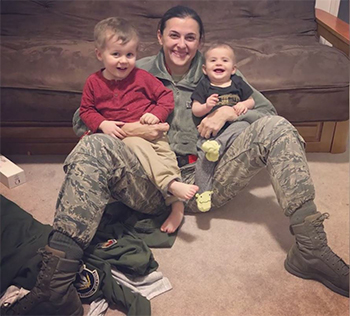 Air Force Lt. Col. Angelina Stephens eventually sought help from a mental health counselor, and prevailed over the stigma associated with seeking medical treatment for mental illness (Still shot from video by Air Force Airman Natalie Rubenak, Mountain Home AFB).
Air Force Lt. Col. Angelina Stephens eventually sought help from a mental health counselor, and prevailed over the stigma associated with seeking medical treatment for mental illness (Still shot from video by Air Force Airman Natalie Rubenak, Mountain Home AFB).
The Stigma: Fear of medical intervention
I was in an extremely distracting headspace. It was all consuming, but when I see pictures or memories, I can vividly recall almost every moment of that year unlike any other moments of my life. I was focusing intensely on every little thing, having to work so hard to see clearly, I noticed everything. As a person who is extremely self-aware, I struggle with the fact that I couldn't see how far I'd strayed from the person I once was.
If I had sought help earlier, I would have less rubble and fewer broken pieces to reassemble on the back end. The associated stigmas and fear keep many of us from seeking the treatment we need, but my family and career would have survived and I would still be where I am today. My husband and I both realize that the stigmas of seeking mental health as military members, especially as officers, had a huge impact on our journey. Understanding that there's a point where mental illness needs medical treatment, no matter the support system or resiliency of the individual, was a lesson we learned the hard way.
I was incredibly lucky that the worst of my mental illness resolved itself before my ideations came to fruition. But if we had it to do over again, we wouldn't try to face it alone. It takes professional intervention to beat the most severe illnesses we face as humans. Mental illness is no different.
Fear of medical intervention takes lives at an alarming rate. Not because people are beyond saving, but many people lost to suicide are fighting something they don't understand, and never even attempt to get the life-saving care they need.
Breaking Through the Stigma: Creating a new narrative
I would have NEVER considered myself suicidal. I never actively thought about committing suicide.
My existence was a fight for survival every day and I'm lucky I'm still here to talk about it. My story could have ended differently, my survival relied on luck and circumstances. Now my journey is focused on creating a world where mental illness is just as easy to talk about as any other medical condition, without fear of judgment, with a focus on healing, recovery and support along the way.
To the person reading this who is fighting their own battle; it doesn't have to be this hard, you don't have to do it alone. You aren't weak for needing help. The world would NOT be better off without you. Your leaders, peers and subordinates won't look down on you for getting help. Many of us can relate more than you'll ever know.
It has been about four years since the fog lifted and the noise grew quiet enough for me to begin my path to recovery. At first, I struggled to realize that I couldn't fully rejoin my life until I went back and acknowledged what I went through. I was fighting to put everything behind me, instead of allowing myself to learn from my own mistakes.
Looking Forward: Learning to embrace life
I look back on two years of Command, the most incredible experience of my Air Force career, which has only been strengthened by my ability to face and share my own experience. I wonder how much stronger we would be as Airmen if we fought together to defeat the stigmas that keep us from being the best versions of ourselves.
The last year hasn't been easy, but with every hard conversation I feel stronger. Every time I find a new way to express the hardest parts of what I went through, the words help me put the pieces back together. Just like any obstacle in life, I look back and see things I should have done differently but I continue to move forward and choose to focus on the future I see in front of me.
I choose to focus on leaving clear footprints that show a better path for those who come behind me, helping others find the words to describe something they don't yet understand, and to overcome the fear that keeps them from getting the support they need and deserve.
Most importantly, I see a life I could have missed altogether.
I see my son, now almost 5 years old, sneaking out of bed early to claim a lap seat for his favorite superhero cartoon, staring up at me with the same big blue eyes that showed me the way through the darkness.
I see my daughter, now 3 years old, full of joy and determination, making the world brighter for every path she crosses, who wouldn't be here if I had chosen a different path for myself.
I see my husband by my side, my rock and soulmate, looking forward to a life of adventure with our family, stronger together because he was willing to guide me through the fire and discover what waited for us on the other side.
I see a life of infinite possibilities, and I'm grateful every second of every day that I'm here to live it.